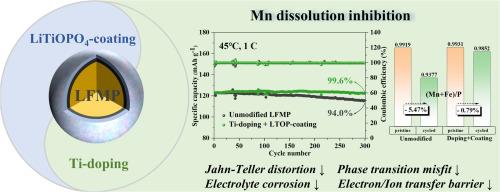Inhibiting Manganese Dissolution in LiFe0.4Mn0.6PO4 Through Synergistic Effect of Ti-Doping and LiTiOPO4-Coating
IF 20.2
1区 材料科学
Q1 CHEMISTRY, PHYSICAL
引用次数: 0
Abstract
Lithium iron manganese phosphate (LiFe0.4Mn0.6PO4, LFMP) cathodes offer higher energy density than LiFePO4 but face challenges with poor cycle stability, primarily due to severe manganese dissolution caused by Jahn-Teller distortion, phase transition stress, and electrolyte corrosion. This study proposes a dual Ti-modification strategy combining Ti-doping and LiTiOPO4 (LTOP) coating to address these challenges. The Ti-doped LFMP@C@LTOP (LFMP-Ti5) was synthesized via a scalable spray-drying method. Ti-doping reduces octahedral distortion, alleviates lattice misfit during phase transitions, and enhances lithium-ion diffusion. Meanwhile, the LTOP coating suppresses Mn dissolution by shielding the cathode from interfacial side reactions. Electrochemical tests demonstrate that LFMP-Ti5 retains capacity of 92.4% after 900 cycles at 1C (room temperature) and 99.6% after 300 cycles at 45°C, outperforming unmodified LFMP (84.5% and 94.0%, respectively). Structural and spectroscopic analyses confirm reduced Mn dissolution (0.79% in LFMP-Ti5 vs. 5.47% in LFMP), minimal lattice volume change (−0.11% vs. −0.93%), reduced lattice volume misfits (6.2% vs. 6.7%), and suppressed Jahn-Teller distortion in charged states. The synergistic Ti-doping and LTOP-coating strategy effectively stabilizes the LFMP structure, and the practical usability of LFMP-Ti5 is validated by the excellent performance in pouch cells.

ti掺杂与liopo4涂层协同抑制LiFe0.4Mn0.6PO4中锰的溶解
磷酸铁锰锂(LiFe0.4Mn0.6PO4, LFMP)阴极具有比LiFePO4更高的能量密度,但面临循环稳定性差的挑战,主要是由于jann - teller畸变、相变应力和电解质腐蚀引起的严重锰溶解。本研究提出了一种结合钛掺杂和LTOP涂层的双钛改性策略来解决这些挑战。采用可扩展喷雾干燥法合成了掺钛LFMP@C@LTOP (LFMP-Ti5)。ti掺杂降低了八面体畸变,减轻了相变过程中晶格失配,增强了锂离子的扩散。同时,LTOP涂层通过屏蔽阴极的界面副反应抑制锰的溶解。电化学测试表明,LFMP- ti5在1C(室温)下循环900次后保持92.4%的容量,在45°C下循环300次后保持99.6%的容量,优于未经改性的LFMP(分别为84.5%和94.0%)。结构和光谱分析证实,LFMP- ti5降低了Mn溶解(LFMP- ti5为0.79%,LFMP为5.47%),晶格体积变化最小(- 0.11%,LFMP为- 0.93%),晶格体积不匹配减少(6.2%,LFMP为6.7%),并抑制了电荷态的jan - teller畸变。ti掺杂和ltop涂层的协同策略有效地稳定了LFMP结构,并且LFMP- ti5在袋状电池中的优异性能验证了其实用性。
本文章由计算机程序翻译,如有差异,请以英文原文为准。
求助全文
约1分钟内获得全文
求助全文
来源期刊

Energy Storage Materials
Materials Science-General Materials Science
CiteScore
33.00
自引率
5.90%
发文量
652
审稿时长
27 days
期刊介绍:
Energy Storage Materials is a global interdisciplinary journal dedicated to sharing scientific and technological advancements in materials and devices for advanced energy storage and related energy conversion, such as in metal-O2 batteries. The journal features comprehensive research articles, including full papers and short communications, as well as authoritative feature articles and reviews by leading experts in the field.
Energy Storage Materials covers a wide range of topics, including the synthesis, fabrication, structure, properties, performance, and technological applications of energy storage materials. Additionally, the journal explores strategies, policies, and developments in the field of energy storage materials and devices for sustainable energy.
Published papers are selected based on their scientific and technological significance, their ability to provide valuable new knowledge, and their relevance to the international research community.
 求助内容:
求助内容: 应助结果提醒方式:
应助结果提醒方式:


